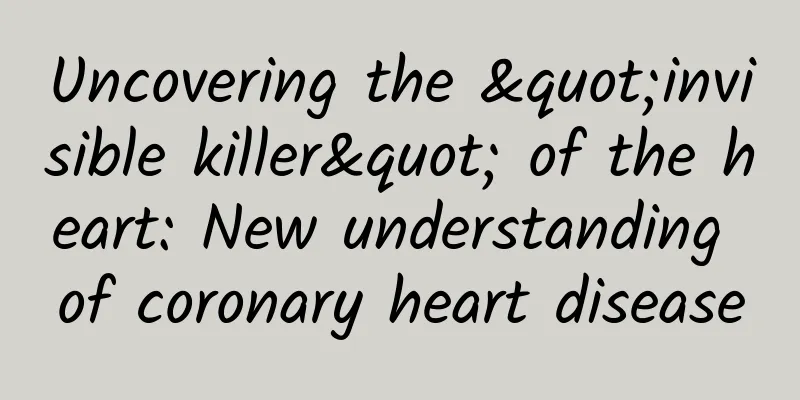Uncovering the "invisible killer" of the heart: New understanding of coronary heart disease

|
Uncovering the "invisible killer" of the heart: New understanding of coronary heart disease Author: Miao Suping, Shanghai Sixth People's Hospital Late at night, the silence of the hospital emergency room was broken by a burst of hurried footsteps. 55-year-old Mr. Zhang, holding his chest and in pain, was supported by his family. He was pale, sweat was oozing from his forehead, and he was gasping for breath. The doctor quickly saw him and, after a series of tests, confirmed that Mr. Zhang had an acute attack of coronary heart disease. What is Coronary Heart Disease Coronary heart disease is a cardiovascular disease caused by coronary atherosclerosis. When plaques are formed on the inner wall of the coronary artery, the blood vessels are narrowed or blocked, and the myocardium cannot get enough blood supply, which leads to ischemia, hypoxia and even necrosis. Its symptoms include angina pectoris and myocardial infarction, which often occur after fatigue, emotional excitement or a full meal. Coronary heart disease is associated with risk factors such as hypertension, hyperlipidemia and diabetes. Prevention requires controlling these risks, maintaining a healthy lifestyle and maintaining heart health. The "hidden killer" of coronary heart disease Coronary heart disease is not something that happens overnight. There are often multiple risk factors behind it. For Mr. Zhang, long-term high blood pressure, high blood lipids and irregular work and rest habits are all the culprits that lead to the onset of coronary heart disease. These "hidden killers" unknowingly erode Mr. Zhang's cardiovascular system, eventually leading to the occurrence of coronary heart disease. However, coronary heart disease is not unpreventable. We can effectively reduce the risk of coronary heart disease by eating a proper diet, exercising moderately, quitting smoking and limiting alcohol consumption, and controlling weight. At the same time, regular physical examinations and timely detection and treatment of diseases such as high blood pressure and high blood lipids are also important means of preventing coronary heart disease. "Warning signs" of coronary heart disease There are often some warning signs before coronary heart disease attacks, such as chest tightness, chest pain, palpitations, etc. Although these signals are short-lived, they cannot be ignored. For Mr. Zhang, it was the appearance of these "warning signals" that made him realize his physical condition in time and take emergency measures. However, in real life, many people turn a blind eye to these warning signs, thinking that they are just minor problems and not worth making a fuss about. Little do they know that such neglect often leads to tragedy. Therefore, we must always pay attention to our physical condition. Once we find any abnormality, we must seek medical treatment in time to avoid missing the best time for treatment. The battle against and recovery from coronary heart disease The treatment of coronary heart disease is a long process that requires joint efforts of patients and doctors. During the acute attack period, doctors will develop personalized treatment plans based on the patient's specific conditions, such as drug therapy, interventional therapy, etc. After the condition stabilizes, patients also need long-term rehabilitation treatment and health management. Rehabilitation treatment includes sports rehabilitation, psychological rehabilitation and dietary rehabilitation. Through scientific exercise plans, psychological adjustment and dietary adjustments, patients can gradually restore their physical functions and improve their quality of life. At the same time, patients also need to go to the hospital for regular review and follow-up to ensure that the disease is controlled and treated in a timely manner. Conclusion: Protecting Heart Health The tense moments in the emergency room for coronary heart disease have made us deeply aware of the importance of heart health. By understanding the causes, prevention, warning signs, treatment and recovery of coronary heart disease, we can better protect our heart health. Let us start from now on, pay attention to heart health, and stay away from the threats of cardiovascular diseases such as coronary heart disease. Let us protect our heart health with a healthy lifestyle, scientific prevention methods and a positive treatment attitude! |
>>: Hot search! Are there fewer lychees this year? Here's how to achieve "lychee freedom" →
Recommend
What should I do if my menstrual flow increases after IUD removal?
The contraceptive ring is an important contracept...
Can pregnant women drink mineral water?
Mineral water is water containing dissolved miner...
Can washing with vinegar help you conceive a girl?
It is not true that washing the vagina with vineg...
Whether a woman is dirty or not depends on this place
Washing your face, brushing your teeth, taking a ...
Uterus pulled out, intestines prolapsed
Uterine prolapse is a common symptom among women....
Can I wash it with salt?
Salt is a common condiment in our daily life and ...
How does muscle aging affect metabolic function? The latest publication by Josef M. Penninger, an academician of the Austrian Academy of Sciences
Source: "BTIT Club" official account As...
What to do if your pregnant belly responds
Conception is a difficult process, and pregnancy ...
What are the differences between koalas and sloths? What do sloths eat?
Sloth (scientific name: Folivora): is the general...
How long can thread carving last?
People who undergo facial thread lifting are more...
What is the cause of brown menstrual period?
Menstruation is something that every woman must e...
Brown discharge during pregnancy
When female friends enter the stage of pregnancy,...
The fastest way for girls to lose masseter muscle
The masticatory muscles have always been one of t...
How long does it take for a primipara to grow from 4 to 10 fingers?
There are two main ways of childbirth: natural bi...
How to treat second degree cervical erosion
Cervical erosion is a very common gynecological d...









